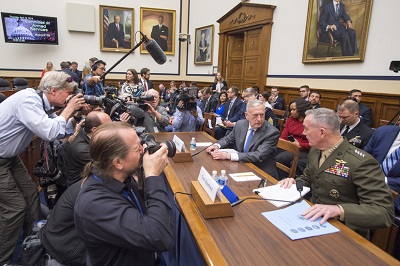U.S. Military Must Develop All-Domain Defenses, Mattis, Dunford Say
Jim Garamone - DoD News

Defense Secretary James N. Mattis and Marine Corps Gen. Joe Dunford, chairman of the Joint Chiefs of Staff, provide testimony on the fiscal year 2019 National Defense Authorization Budget to members of the House Armed Services Committee at the Rayburn House Office Building in Washington D.C., April 12, 2018. DoD Photo by Navy Petty Officer 1st Class Dominique A. Pineiro.
If a nation wants to challenge the United States conventionally, that nation will lose.
So, nations won’t challenge America conventionally, but look for asymmetric ways to do so, DoD’s most-senior civilian and military leaders said to the House Armed Services Committee yesterday.
Defense Secretary James N. Mattis and Marine Corps Gen. Joe Dunford, the chairman of the Joint Chiefs of Staff, also spoke about the problems caused by “gray zone” warfare.
Right now, the U.S. military is practiced in counterinsurgency operations. The defeat-Islamic State of Iraq and Syria campaign has honed the skills needed to train local troops and provide troops with enablers like close air support and logistics.
If groups like al-Qaida and ISIS were the only threats, then counterinsurgency forces would be fine. But Russia and China will be long-term competitors, and both countries are developing capabilities to challenge U.S. dominance. These areas include the cyber world, space and information operations.
It also includes anti-access strategies like building islands in the South China Sea.
Develop, Maintain Overmatch, Reassure Allies
The United States must develop and maintain overmatch in all domains of combat, and continue to reassure allies. “What we will do is make certain our allies know that we’re reliable and we can break through to them,” Mattis said. “We can get to them and stand with them at the time of need.”
This asymmetric challenge is sometimes described at the “gray zone” or the Gerasimov doctrine -- after the Russian chief of General Staff Gen. Valery Gerasimov -- or even as “little green men.”
Dunford described the strategy as the use of “political influence, economic coercion, use of cyber, use of information operations and then military posture,” during his testimony.
“So there's a military dimension to it, but it's clearly a broader problem than just a military dimension,” the general added.
The bottom line is that the competition taking place inside the gray zone “is really the competition for our allies and partners,” he said.
What the Russians are trying to do in the gray zone is undermine the credibility of U.S. alliances and partnerships, the general said. “So what’s critical for us to do is overcome in the information space, overcome in cyber capabilities, and then our military posture, the erosion of that relationship that we have with our allies,” Dunford said.
Interagency Participation
This requires broader government participation. The State Department, Treasury, the intelligence agencies, U.S. Agency for International Development and more need to be involved to bring some resolution to the gray zone.
Dealing within the gray zone is even more complicated because of the way the United States military thinks about conflict. The gray zone is predicated on a continuum between peace and war. The United States military sees an on/off switch between the two.
“The activities and the authorities that we have in place on a day-to-day basis reflect the fact that we’re at peace, and our adversaries don’t actually have the same restraints,” the chairman said. “So what they’re doing on a day-to-day basis looks more like moving towards war than being in peace.”
DoD is reviewing the issue. “We do believe that we are limited in the activities that we can perform on a day-to-day basis and the authorities that we have to allow us to be competitive,” Dunford said.
(Follow Jim Garamone on Twitter: @GaramoneDoDNews)
